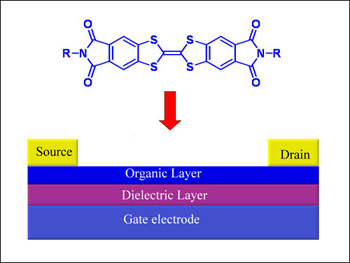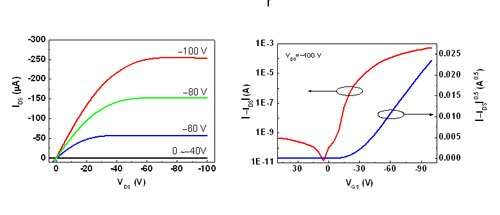| |
By Xike Gao, Ying Wang, Xiaodi Yang, Yunqi Liu,* Wenfeng Qiu, Weiping Wu, Hengjun Zhang, Ting Qi, Ying Liu, Kun Lu, Chunyan Du, Zhigang Shuai, Gui Yu and Daoben Zhu*
(Beijing National Laboratory for Molecular Sciences, Key Laboratory of Organic Solids, Institute of Chemistry, Chinese Academy of Sciences, Beijing 100080 (P. R. China)
E-mail: liuyq@mail.iccas.ac.cn )
A new class of organic species, dibenzotetrathiafulvalene (DBTTF) bisimides (Fig. 1), were designed and synthesized by a general synthetic strategy. The physical properties and field-effect transistors (FET, Fig. 1) characteristics of the first two members of DBTTF bisimides (1 and 2) were studied. Their thin film devices fabricated at room temperature showed excellent p-type FET performance in air, with high mobility up to 0.40 cm2/Vs and even high on/off ratio of 106-108 (Fig. 2). As an emerging class of conjugated materials, DBTTF bisimides would possess a diverse library of derivatives with various functionalities at the imide rings and their applications in organic electronics are promising.
Adv. Mater. (2007, 19, 3037-3042)

Figure 1. Molecular structure of DBTTF and schematic of field-effect transistors.

Figure 2. Output characteristics and transfer characteristics of DBTTF bisimide field-effect transistors.
, |
|
